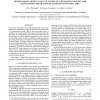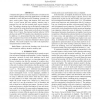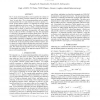124
Voted
ICASSP
2011
IEEE
14 years 4 months ago
2011
IEEE
— In this paper, we propose a new on-line learning algorithm for the non-linear system identification: the swarm intelligence aided multi-innovation recursive least squares (SIM...
ICASSP
2011
IEEE
14 years 4 months ago
2011
IEEE
We show the powerful sparse signal recovery approach FOCUSS is a convex-concave procedure. It follows a Newton-like decent direction by retaining the positive definite component ...
ICASSP
2011
IEEE
14 years 4 months ago
2011
IEEE
Speech inversion is a way of estimating articulatory trajectories or vocal tract configurations from the acoustic speech signal. Traditionally, articulator flesh-point or pellet t...
122
click to vote
ICASSP
2011
IEEE
14 years 4 months ago
2011
IEEE
We describe and evaluate our toolkit openBliSSART (open-source Blind Source Separation for Audio Recognition Tasks), which is the C++ framework and toolbox that we have successful...
102
click to vote
ICASSP
2011
IEEE
14 years 4 months ago
2011
IEEE
This paper considers the decomposition of a complex matrix as the product of several sets of semi-unitary matrices and upper triangular matrices in iterative manner. The inner mos...
ICASSP
2011
IEEE
14 years 4 months ago
2011
IEEE
An extension of principal component analysis called ipPCA has been proposed earlier for analyzing structure in genetic data. This non-parametric framework iteratively classifies ...
ICASSP
2011
IEEE
14 years 4 months ago
2011
IEEE
A detailed description of tone and intonation is beneficial for many spoken language processing applications. In traditional methods for tone and pitch accent modeling, prosodic ...
140
click to vote
ICASSP
2011
IEEE
14 years 4 months ago
2011
IEEE
Monitoring and tracking human activities around restricted areas is an important issue in security and surveillance applications. The movement of different parts of the human body...
126
click to vote
ICASSP
2011
IEEE
14 years 4 months ago
2011
IEEE
We consider the problem of energy-efficient point-to-point transmission of delay-sensitive data (e.g. multimedia data) over a fading channel. We propose a rigorous and unified fra...
103
click to vote
ICASSP
2011
IEEE
14 years 4 months ago
2011
IEEE
The K-means clustering problem seeks to partition the columns of a data matrix in subsets, such that columns in the same subset are ‘close’ to each other. The co-clustering pr...



